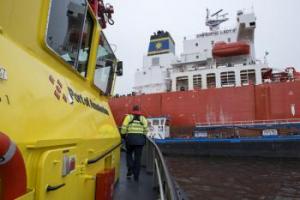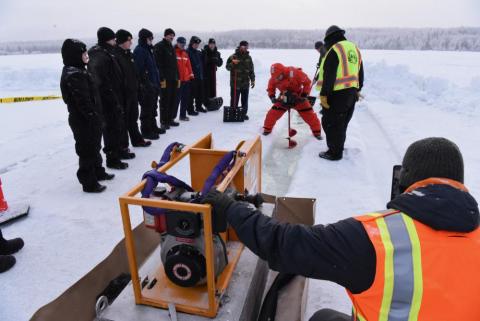Harbour Master
Harbour Masters
Worldwide there are approximately 3,000 merchant ports and the work of the Harbour Master can vary widely from country to country and from port to port even within the same country.


It was reported on 3 February from Joint Base Elmendorf-Richardson in Alaska that staff from the US Coast Guard (USCG), Alaska Department of Environmental Conservation (ADEC), and Navy Supervisor of Salvage (SUPSALV) participated in an ice-based pollution response exercise at the base in Anchorage from 30 January to 3 February.
SUPSALV’s contractor, Global PCCI (GPC), simulated an oil spill on Otter Lake and demonstrated various containment and recovery methods suitable for Arctic conditions. One such method was use of a rope mop skimmer, which involved digging a trench, without penetrating through the layer of ice, and drilling holes in the trench down into the water. This method allows for oil to float up through the holes and become contained in the trench. There the oil is collected by a rope mop skimmer, which uses oil-attracting fibres to pick up the oil and transfer it to a holding tank.
To quote Lieutenant Andrew Ratti, Sector Anchorage, Incident Management Division: ‘This is an exceptional opportunity for our partners to come together to exchange knowledge, practice recovery techniques, and test equipment before an actual incident.
‘We are learning the practical application of tactics and techniques, but we are also networking to ensure better communication when we need to coordinate efforts at an actual incident.’
Coast Guard staff from Anchorage, Juneau and the Great Lakes Oil Spill Center of Expertise (GLCOE) in Sault St. Marie, Michigan, gained hands-on experience building containment berms, using ice augers, and setting up fast erect tanks. Participants also practiced a diversionary technique using plywood to divert oil trapped beneath ice to a designated location for clean up.
Anna Carey, ADEC State On-Scene Coordinator, reflected: ‘Oil spill exercises provide a safe, collaborative environment where members of the response community can work together and exchange knowledge, ideas and concerns.
‘Exercises are especially important in Alaska where weather conditions, remote locations and availability of response equipment and personnel make oil response especially challenging.’
Picture caption
Members of the Coast Guard, Alaska Department of Environmental Conservation, and Navy Supervisor of Salvage conduct an oil-spill-on-ice training exercise at Joint Base Elmendorf-Richardson, Alaska, on 1 February2023.
The exercise was structured to comply with the OPA-90 National Preparedness for Response Exercise Program (NPREP) training and drill requirements for deploying oil spill response gear in Arctic conditions within the Alaska geographical area of responsibility.
US Coast Guard photo by Petty Officer 1st Class Nate Littlejohn.
USCG ©
The International Harbour Masters Association (IHMA) and the Port of Rotterdam Authority are pleased to announce the 15th International Harbour Masters Association Congress, to be held from 09–12 June 2026 at Theater Zuidplein in Rotterdam.
Naresh Sewnath, Senior Harbour Master at Transnet National Ports Authority (TNPA) in South Africa’s Port of Durban, began his maritime career back in 1988. He started out as a cadet with TNPA (then known as South African Transport Services (SATS).